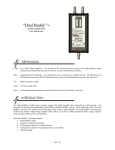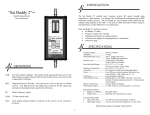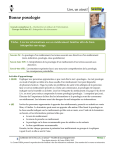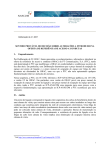Download PRE-SURGERY INSTRUCTIONS: BREAST AUGMENTATION
Transcript
POST-SURGERY INSTRUCTIONS: SCAR REVISION SURGICAL Once your scar revision is completed, you must follow all the instructions given to you in order to heal properly and have a good outcome. The following instructions are your obligation. Use this as a checklist of progress as you heal. Included are normal post-surgical experiences and key health considerations that may be a cause of concern. TYPICAL POST-OPERATIVE SYMPTOMS Typical symptoms to watch for following surgical scar revision include the following: Tingling, burning, redness, tightness at the surgical site. These are normal experiences as the skin, tissues and sensory nerves heal. Pain medication will help you cope with any discomfort. Consistent sharp pain should be reported to our office immediately. You may also feel minor discomfort at the graft donor site, if you had your own skin grafted to revise the scar. Shiny skin or any itchy feeling: Swelling can cause the breast’s skin to appear shiny. As the healing process advances, you may also find a mild to severe itchy feeling of the breasts. An antihistamine like Benadryl can help to alleviate severe, constant itchiness. If the skin becomes red and hot to the touch, contact our office immediately. CALL THE OFFICE IMMEDIATELY IF YOU EXPERIENCE ANY OF THE FOLLOWING: A high fever, (over 101º) severe nausea and vomiting, continued dizziness or incoherent behavior, such as hallucinations. Any pain that cannot be controlled by your pain medication. Bright red skin that is hot to the touch. Excessive bleeding or fluid seeping through the incisions. A severely misshapen breast or bruising that is localized to one breast or region of the chest. To alleviate any discomfort, and to reduce swelling, you may apply cool, not cold compresses to the treated region. Crushed ice or ice packs must be wrapped in a towel before being applied to the skin. Do not apply ice or anything frozen directly to the skin. Apply cool compresses, for no longer than 20-minute intervals. DAY OF SURGERY INSTRUCTIONS If you have had sedation of any kind, you will only be released to the care of a responsible adult. All of these instructions must be clear to the adult who will monitor your health and support you, around the clock in the first 24 hours following surgery. Rest, but not bed rest. While rest is important in the early stages of healing, equally important is that you are ambulatory: meaning that you are walking under your own strength. Spend 10 minutes every 2 hours engaged in light walking indoors as you recover. Keep the wound site elevated. If the scar revision is of the face or upper body, a reclined position is best. If your scar revision is of the lower body, keep your legs elevated. Good nutrition: Fluids are critical following surgery. Stick to non-carbonated, non-alcoholic, caffeine-free, and green tea-free beverages including fruit juices and water, milk, and yogurt drinks. You must consume at least 8 ounces of fluid every 2 hours. Stick with soft, bland, nutritious food for the first 24 hours. Take all medication, exactly as prescribed. If you have a pain pump, follow the instructions specifically for your pain pump. Oral pain medication, antibiotics and other medications you must take include: o Antibiotic o Pain Medication o Muscle Relaxant o Other o Supplements Change your incision dressings. Your incisions will seep fluid and some blood for a short time after surgery. Keep dressings clean and dry. A cotton swab with peroxide is appropriate for cleansing incisions. Do not remove any steri-strips over your stitches. Apply anti-bacterial ointment over the steri-strips, and then apply a gauze pad. If you have a drain placed in your incisions, carefully follow the instructions for drain care and record drained fluid on the Drain Care Instructions and Log. Wear compression as directed. If you are given a compression garment, wrap, or tape to wear, you must wear this around the clock, as directed. If you do not follow these instructions, your scar revision can result in the formation of irregular, raised scars. Do not smoke. Smoking can greatly impair your safety prior to surgery and your ability to heal following surgery. You must not smoke. Post Surgery – Instruction Page 1 of 2 ©2005 American Society of Plastic Surgeons ®. POST-SURGERY INSTRUCTIONS: SCAR REVISION SURGICAL Relax. Do not engage in any stressful activities. Do not lift your hands over your head. Do not lift anything heavier than a paperback book. Take care of no one, including you. Let others tend to you. TWO TO SEVEN DAYS FOLLOWING SURGERY During this time you will progress with each day that passes. Ease into your daily activities. Continue to cleanse wounds as directed; you may shower. Take a warm, not hot shower. Do not take a bath. Limit your shower to 10 minutes. Do not remove any steri-strips. Do not rub your incisions. Apply a fragrance free moisturizer to breast and surrounding skin, however not on your incisions. Take medications and supplements as directed. Pain medication such as acetaminophen or ibuprofen should ease your discomfort. Proper sun protection is vital. You must not allow direct or indirect sun exposure to your wounds. Wear protective clothing, a wide-brimmed hat and at least an SPF 30 if you must be outdoors. Do not resume any exercise other than regular walking. Walking is essential every day to prevent the formation of blood clots. Maintain a healthy diet. Do not smoke. Do not consume alcohol. ONE TO FOUR WEEKS FOLLOWING SURGERY As you resume your normal daily activities, you must continue proper care and healing. Discomfort or tightness and tingling will resolve. Continue wound care as directed. This includes any ointment, compression tape or other instructions you have been given. Ease into your fitness routine. Avoid aerobic exercise that may stress or stretch the skin in the area of your scar revision. Do not smoke. While incisions may have sealed, smoking deprives your body of necessary oxygen that can result in poorly healed, wide, raised scars. Practice good sun protection. Do not expose your breasts to direct sunlight. If you are outdoors, apply at least an SPF 30 to the chest area at least 30 minutes prior to sun exposure. Your chest region and breast skin are highly susceptible to sunburn or the formation of irregular, darkened pigmentation. YOUR FIRST YEAR Continue healthy nutrition, fitness, and sun protection. Your scars will continue to refine. If they become raised, red or thickened, or appear to widen, contact our office. Early intervention is important to achieving well-healed scars. Scars are generally refined to fine incision lines one year after surgery. A one-year post surgery follow-up is recommended. However, you may call our office at any time with your concerns or for needed follow-up. Your skin and scars may change with age. Contact our office with any of your questions or concerns, at any time. Post Surgery – Instruction Page 2 of 2 ©2005 American Society of Plastic Surgeons ®.










